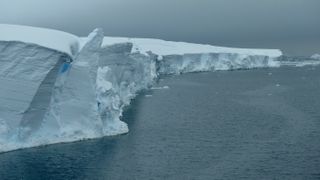Antarctica's 'Doomsday Glacier' is hemorrhaging ice faster than in the past 5,500 years
Ancient bones revealed how fast the melting ice raised the Antarctic shorelines.

Antarctica's so-called Doomsday Glacier is losing ice at its fastest rate in 5,500 years, raising concerns about the ice sheet's future and the possibility of catastrophic sea level rise caused by the frozen continent's melting ice.
The finding comes from a study of prehistoric sea-deposits found on the shores surrounding the "doomsday" Thwaites Glacier and the neighboring Pine Island Glacier, both located on the West Antarctic Ice Sheet. The chilling news? Antarctica's glacial melt, driven by climate change, is advancing faster than ever before in recorded history, researchers have reported June 9 in the journal Nature Geoscience.
"These currently elevated rates of ice melting may signal that those vital arteries from the heart of the West Antarctic Ice Sheet have been ruptured, leading to accelerating flow into the ocean that is potentially disastrous for future global sea level in a warming world," co-author Dylan Rood, an Earth scientist at Imperial College London, said in a statement.
"Is it too late to stop the bleeding?" Rood asked.
As one of Antarctica's fastest-melting glaciers, Thwaites has earned the nickname"Doomsday Glacier." Since the 1980s, Thwaites has lost an estimated 595 billion tons (540 billion metric tons) of ice, contributing to a 4% rise in global sea levels. Thwaites and its northern neighbor, the Pine Island Glacier, cover enormous expanses; Thwaites has a surface area of about 74,130 square miles (192,000 square kilometers) (making it nearly as big as Great Britain) and Pine Island 62,660 square miles (162,300 square km).
As the sea-facing ends of the glaciers are positioned above a bowl-like ocean basin, both glaciers are exposed on their undersides to currents of warm, dense, salty water. This warm water isn't just melting the glaciers where they extend into the Amundsen Sea, but it is also whittling away at them from underneath, unpinning them from their main anchoring points located to the north. Additionally, this melt from below weakens the glaciers and makes them more prone to surface fractures, which could spread across the entire ice sheet, and potentially cause it to shatter. If the entirety of the West Antarctic Ice Sheet were to break up and melt into the sea, it would elevate global sea levels by approximately 11 feet (3.4 meters).
To compare the glaciers' melt rates today with those of the distant past, scientists looked for clues on Antarctic beaches close to where the glaciers terminated at the ocean. Ice weighs down land, so as some of that frozen weight melted and drained into the sea toward the end of the last ice age (around 11,500 years ago) the land rebounded to reveal shorelines that were previously hidden beneath the waves. By measuring the ages and heights of nearly two dozen shorelines, the scientists hoped to discover how quickly ice disappeared from the land before advancing again.
Sign up for the Live Science daily newsletter now
Get the world’s most fascinating discoveries delivered straight to your inbox.
The researchers estimated the ages of the shorelines by collecting ancient shells and tiny fragments of penguin bones, before analyzing the ancient biomatter with radiocarbon dating. This method identifies the age of organic material by measuring the amount of carbon-14, a radioactive carbon isotope, or variant with a different number of neutrons, which is found everywhere on Earth and is easily absorbed by plants and animals. When animals die, they stop accumulating carbon-14 in their tissues and the amount that they've already absorbed begins to decay. The half-life of carbon-14 (or the time it takes for half of it to decay) is 5,730 years, and scientists can pinpoint the ages of animals that died thousands of years ago by measuring quantities of undecayed carbon-14 in the remains.
After dating penguin bones and shells from more than 20 different shorelines, the scientists found that the oldest and highest beach began to form roughly 5,500 years ago. From that moment in time until about 30 years ago, ice loss exposed the shorelines at a rate of about 0.14 inches (3.5 millimeters) each year, the researchers reported. But over the past three decades, the rate of shoreline advance has skyrocketed — up to 1.6 inches (40 mm) per year.
"Although these vulnerable glaciers were relatively stable during the past few millennia, their current rate of retreat is accelerating and already raising global sea levels," Rood said.
What this means for the future of Antarctica's glaciers and ice sheet — and vulnerable coastlines around the globe — is unclear. The researchers' findings, while alarming, don't address how many times the glaciers may have retreated and readvanced across recorded history. The scientists hope to figure this out by drilling through the ice to sample rock of the landmass underneath it, which could show if the current rate of melt is reversible, or if the glaciers have truly passed a point of no return.
Originally published on Live Science.

Ben Turner is a U.K. based staff writer at Live Science. He covers physics and astronomy, among other topics like tech and climate change. He graduated from University College London with a degree in particle physics before training as a journalist. When he's not writing, Ben enjoys reading literature, playing the guitar and embarrassing himself with chess.
Most Popular

